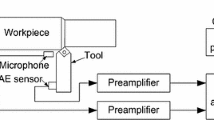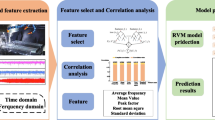Abstract
A new type of continuous hybrid tool wear estimator is proposed in this paper. It is structured in the form of two modules for classification and estimation. The classification module is designed by using an analytic fuzzy logic concept without a rule base. Thereby, it is possible to utilize fuzzy logic decision-making without any constraints in the number of tool wear features in order to enhance the module robustness and accuracy. The final estimated tool wear parameter value is obtained from the estimation module. It is structured by using a support vector machine nonlinear regression algorithm. The proposed estimator implies the usage of a larger number and various types of features, which is in line with the concept of a closer integration between machine tools and different types of sensors for tool condition monitoring.
Similar content being viewed by others
Explore related subjects
Discover the latest articles and news from researchers in related subjects, suggested using machine learning.References
Alonso F. J., Salgado R. J. (2008) Analysis of the structure of vibration signals for tool wear detection. Mechanical Systems and Signal Processing 22: 735–748
Balazinski M., Czogala E., Jemielniak K., Leski J. (2002) Tool condition monitoring using artificial intelligence methods. Engineering Applications of Artificial Intelligence 15: 73–80
Burges C. J. C. (1998) A tutorial on support vector machines for pattern recognition. Data Mining and Knowledge Discovery 2: 121–167
Chen J. C., Chen J. C. (2004) An artificial-neural-networks-based in-process tool wear prediction system in milling operations. The International Journal of Advanced Manufacturing Technology 21: 339–347
Chungchoo C., Saini D. (2002) On-line tool wear estimation in CNC turning operations using fuzzy neural network model. International Journal of Machine Tools & Manufacture 42: 29–40
Danai K. (2002) Machine tool monitoring and control. In: Osita D., Nwokah I., Hurmuzlu Y. (eds) Mechanical systems design handbook (Section I). CRC Press, Boca Raton
Ghasempoor A., Jeswiet J., Moore T. N. (1999) Real time implementation of on-line tool condition monitoring in turning. International Journal of Machine Tools and Manufacture 39: 1883–1902
Ghosh N., Ravi Y. B., Patra A., Mukhopadhyay S., Paul S., Mohanty A. R., Chattopadhyay A. B. (2007) Estimation of tool wear during CNC milling using neural network-based sensor fusion. Mechanical Systems and Signal Processing 21: 466–479
Hong G. S., Rahman M., Wong Y. S. (2001) Tool condition monitoring in manufacturing systems using neural networks. In: Leondes C. (eds) Computer aided design, engineering and manufacturing (Vol. VII): Artificial intelligence and robotics in manufacturing. CRC Press, Boca Raton, pp 4-1–4-39
Huang P.-T., Chen J. C. (2000) Neural network-based tool breakage monitoring system for end milling operations. Journal of Industrial Technology 16(2): 1–8
Jemielniak K. (1999) Commercial tool condition monitoring systems. The International Journal of Advanced Manufacturing Technology 15: 711–721
Kamarthi S. V., Kumara S. R. T., Cohen P. H. (2000) Flank wear estimation in turning through wavelet representation of acoustic emission Signals. Journal of Manufacturing Science and Engineering 122: 12–19
Kecman V. (2001) Learning and soft computing: Support vector machines, neural networks, and fuzzy logic models. The MIT Press, Cambridge, MA
Landers R. G., Ulsoy A. G., Furness R. J. (2002) Process monitoring and control of machining operations. In: Osita D., Nwokah I., Hurmuzlu Y. (eds) Mechanical systems design handbook (Section I). CRC Press, Boca Raton
Li X., Dong S., Venuvinod P. K. (2000) Hybrid learning for tool wear monitoring. The International Journal of Advanced Manufacturing Technology 16: 303–307
Li X., Li H.-X., Guan X.-P., Du R. (2004) Fuzzy estimation of feed-cutting force from current measurement—A case study on intelligent tool wear condition monitoring. IEEE Transactions on Systems, Man and Cybernetics – Part C: Applications and Reviews 34(4): 506–512
Li X., Tso S. K., Wang J. (2000) Real-time tool condition monitoring using wavelet transforms and fuzzy techniques. IEEE Transactions on Systems, Man and Cybernetics – Part C: Applications and Reviews 30(3): 352–357
Liang Y. S., Hecker L. R., Landers G. R. (2004) Machining process monitoring and control: The state of the art. Journal of Manufacturing Science and Engineering 126: 297–310
Lo S.-P. (2002) The application of an ANFIS and grey system method in turning tool-failure detection. The International Journal of Advanced Manufacturing Technology 19: 564–572
Mehrabi M. G., Ulsoy A. G., Koren Y. (2002) Manufacturing systems and their design principles. In: Osita D., Nwokah I., Hurmuzlu Y. (eds) Mechanical systems design handbook (Section I). CRC Press, Boca Raton
Misiti, M., Misiti, Y., Oppenheim, G., & Poggi J.-M. (2005). Wavelet toolbox user’s guide, The MathWorks Inc., http://www.mathworks.com/access/helpdesk/help/pdf_doc/wavelet/wavelet_ug.pdf, Accessed 19 September 2008.
O’Donnell G., Young P., Kelly K., Byrne G. (2001) Towards the improvement of tool condition monitoring systems in the manufacturing environment. Journal of Materials Processing Technology 119: 133–139
Prickett P. W., Johns C. (1999) An overview of approaches to end milling tool monitoring. International Journal of Machine Tools and Manufacture 1: 105–122
Salgado D. R., Alonso F. J. (2007) An approach based on current and sound signals for in-process tool wear monitoring. International Journal of Machine Tools and Manufacture 47: 2140–2152
Scheffer C., Heyns P. S., Klocke F. (2003) Development of a tool wear-monitoring system for hard turning. International Journal of Machine Tools and Manufacture 43: 973–985
Sharma V. S., Sharma S. K., Sharma A. K. (2008) Cutting tool wear estimation for turning. Journal of Intelligent Manufacturing 19: 99–108
Shi D., Gindy N. N. (2007) Tool wear predictive model based on least squares support vector machines. Mechanical Systems and Signal Processing 21: 1799–1814
Sick, B. (1998). On-line tool wear classification in turning with time-delay neural networks and process-specific pre-processing. International Joint Conference on Neural Networks – IJCNN 1998 (pp. 84–89). Anchorage, Alaska.
Sick B. (2002) On-line and indirect tool wear monitoring in turning with artificial neural networks: A review of more than a decade of research. Mechanical Systems and Signal Processing 16(4): 487–546
Silva, R.G. (2009). Condition monitoring of the cutting process using a self-organizing spiking neural network map. Journal of Intelligent Manufacturing, http://www.springerlink.com/content/gw8887538888715v/fulltext.pdf. Accessed 24 September 2009.
Silva R. G., Reuben R. L., Baker K. J., Wilcox S. J. (1998) Tool wear monitoring of turning operations by neural network and expert system classification of a feature set generated from multiple sensors. Mechanical Systems and Signal Processing 12(2): 208–221
Smola, A. J., & Schölkopf, B. (1998). A tutorial on support vector regression. Royal Holloway College-University of London. http://www.kernel-machines.org/publications/SmoSch98c, Accessed 24 October 2009.
Srinivasa P. P., Nagabhushana T. N., Ramakrishna Rao P. K. (2002) Flank wear estimation in face Milling based on radial basis function neural networks. The International Journal of Advanced Manufacturing Technology 20: 241–247
Sun J., Hong G. S., Wong Y. S., Rahman M., Wang Z. G. (2006) Effective training data selection in tool condition monitoring system. International Journal of Machine Tools and Manufacture 46: 218–224
Sun J., Rahman M., Wong Y. S., Hong G. S. (2004) Multiclassification of tool wear with support vector machine by manufacturing loss consideration. International Journal of Machine Tools and Manufacture 44: 1179–1187
Susanto V., Chen J. C. (2003) Fuzzy logic based in-process tool-wear monitoring system in face milling operations. The International Journal of Advanced Manufacturing Technology 21: 186–192
Tandon H., El-Mounayri A. (2001) Novel artificial neural networks force model for end milling. The International Journal of Advanced Manufacturing Technology 10: 693–700
Vapnik V. (1998) Statistical learning theory. J. Wiley & Sons Inc, New York
Venkatesh K., Zhou M., Caudill R. J. (1997) Design of artificial neural networks for tool wear monitoring. Journal of Intelligent Manufacturing 8: 215–226
Wang J., Tang W. S., Roze C. (2001) Neural network applications in intelligent Manufacturing: An updated survey. In: Wang J., Kusiak A. (eds) Computational intelligence in manufacturing handbook (Part I). CRC Press, Boca Raton
Wang X., Wang W., Huang Y., Nguyen N., Krishnakumar K. (2008) Design of neural network-based estimator for tool wear modeling in hard turning. Journal of Intelligent Manufacturing 19: 383–396
Zuperl U., Cus F., Kiker E. (2009) Adaptive network based inference system for estimation of flank wear in end-milling. Journal of Materials Processing Technology 209: 1504–1511
Author information
Authors and Affiliations
Corresponding author
Rights and permissions
About this article
Cite this article
Brezak, D., Majetic, D., Udiljak, T. et al. Tool wear estimation using an analytic fuzzy classifier and support vector machines. J Intell Manuf 23, 797–809 (2012). https://doi.org/10.1007/s10845-010-0436-x
Received:
Accepted:
Published:
Issue Date:
DOI: https://doi.org/10.1007/s10845-010-0436-x




